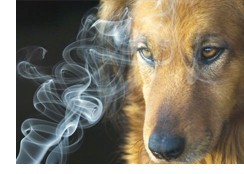
Second hand smoke is not just a danger to humans, it also poses a great risk for pets as well. For various reasons, pets who’s owners smoke can suffer health issues at a much more serious level than pets who’s owners don’t. Here are some facts:
SECOND HAND SMOKE: is defined as smoke that has been exhaled or escapes into the air to be inhaled involuntarily by others, including pets.
THIRD HAND SMOKE: is a residue that remains on skin, clothing, furniture and even pet fur, even after the air is clear.
Both second and third hand smoke pose a danger for pets and humans alike.
EFFECTS ON DOGS
Long term effects of secondary smoke on dogs has been proven to increase the risk of respiratory tract cancer, nasal cancer (which increased by a whopping 250% according to one study) and lung cancer depending on the length of the dog’s nose. For example, long-nosed dogs have greater filtration systems in their nose, protecting the lungs but endangering the nasal passage. Short-nosed dogs allow toxins to pass into the lungs more readily, endangering the lungs. Other non-cancerous diseases, such as asthma and bronchitis, are also more prevalent in these dogs.
EFFECTS ON CATS
Malignant lymphoma is almost 2.5 times higher in cats that are exposed to secondary and third hand smoke, and this risk only increases with time. Oral cancers are also a danger as cats with smoke residue on their fur groom themselves and damage the delicate tissues in their mouths.
Some people may suggest smoking outside, but studies have shown that children of parents who smoke outdoors are still exposed to 5-7 times more tobacco smoke than non-smoking parents, so we can assume that pets are the same. However, outdoors and away from pets is infinitely better than smoking inside or around them. You never know, these facts might be the best reason to quit altogether :).

